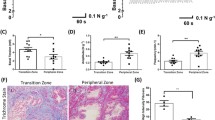Abstract
α1-Adrenoceptor antagonists (α1-blockers) are currently used as first-line drugs for the treatment of benign prostatic hyperplasia (BPH). However, cases of BPH are often encountered in which the efficacy of α1-blockers decreases and switching to surgical treatment is required. One factor responsible for this resistance includes structural changes in prostatic tissue architecture following repeated oral administration of α1-blockers. Forty patients suspected of having prostate cancer, but without evidence of malignancy on prostatic biopsy were divided into two groups: an untreated group (n = 17) and an oral α1-blocker-treated group (n = 23). Twenty-one patients exhibiting resistance to oral α1-blocker therapy who underwent surgery were assigned into the surgically treated group. Each tissue sample was subjected to Masson’s trichrome staining to distinguish collagen fibers from smooth muscle constituting prostatic stroma. The mean collagen fiber share was 62.2 ± 10.4% in the untreated group, 72.1 ± 9.1% in the oral α1-blocker-treated group, and 72.2 ± 15.7% in the surgically treated group. Focusing on cases exhibiting high-collagen fiber share (70% or more), the distribution in each of the two α1-blocker-treated groups (16 of the 23 cases from the oral α1-blocker-treated group and 10 of the 21 cases from the surgically treated group) differed significantly from that in the untreated group (2 of the 17 cases). Our findings suggest that the accumulation of collagen fibers in prostatic stroma could be one of the factors responsible for α1-blocker treatment.


Similar content being viewed by others
References
Berry SJ, Coffey DS, Walsh PC, Ewing LL (1984) The development of human benign prostatic hyperplasia with age. J Urol 132:474–479
Fujikawa S, Matsuura H, Kanai M, Fumino M, Ishii K, Arima K, Shiraishi T, Sugimura Y (2005) Natural history of human prostate gland: morphometric and histopathological analysis of Japanese men. Prostate 65:355–364
McNeal JE (1978) Origin and evolution of benign prostatic enlargement. Invest Urol 15:340–345
Norman JT, Cunha GR, Sugimura Y (1986) The induction of new ductal growth in adult prostatic epithelium in response to an embryonic prostatic inductor. Prostate 8:209–220
Djavan B, Marberger M (1999) A meta-analysis on the efficacy and tolerability of alpha1-adrenoceptor antagonists in patients with lower urinary tract symptoms suggestive of benign prostatic obstruction. Eur Urol 36:1–13
Ichioka K, Ohara H, Terada N, Matsui Y, Yoshimura K, Terai A, Arai Y (2004) Long-term treatment outcome of tamsulosin for benign prostatic hyperplasia. Int J Urol 11:870–875
Masumori N, Hashimoto J, Itoh N, Tsukamoto T, Group TS (2007) Short-term efficacy and long-term compliance/treatment failure of the alpha1 blocker naftopidil for patients with lower urinary tract symptoms suggestive of benign prostatic hyperplasia. Scand J Urol Nephrol 41:422–429
Shapiro E, Hartanto V, Lepor H (1992) The response to alpha blockade in benign prostatic hyperplasia is related to the percent area density of prostate smooth muscle. Prostate 21:297–307
Justulin LA Jr, Delella FK, Felisbino SL (2008) Doxazosin reduces cell proliferation and increases collagen fibers in rat prostatic lobes. Cell Tissue Res 332:171–183
Barry MJ, Williford WO, Chang Y, Machi M, Jones KM, Walker-Corkery E, Lepor H (1995) Benign prostatic hyperplasia specific health status measures in clinical research: how much change in the American Urological Association symptom index and the benign prostatic hyperplasia impact index is perceptible to patients? J Urol 154:1770–1774
Shapiro E, Hartanto V, Lepor H (1992) Quantifying the smooth muscle content of the prostate using double-immunoenzymatic staining and color assisted image analysis. J Urol 147:1167–1170
Bierhoff E, Vogel J, Benz M, Giefer T, Wernert N, Pfeifer U (1996) Stromal nodules in benign prostatic hyperplasia. Eur Urol 29:345–354
Smith P, Rhodes NP, Ke Y, Foster CS (1999) Influence of the alpha1-adrenergic antagonist, doxazosin, on noradrenaline-induced modulation of cytoskeletal proteins in cultured hyperplastic prostatic stromal cells. Prostate 38:216–227
Verrecchia F, Mauviel A (2007) Transforming growth factor-beta and fibrosis. World J Gastroenterol 13:3056–3062
Ishigooka M, Hayami S, Hashimoto T, Suzuki Y, Katoh T, Nakada T (1996) Relative and total volume of histological components in benign prostatic hyperplasia: relationships between histological components and clinical findings. Prostate 29:77–82
Ichiyanagi O, Sasagawa I, Ishigooka M, Suzuki Y, Nakada T (2000) Morphometric analysis of symptomatic benign prostatic hyperplasia with and without bladder outlet obstruction. Urol Res 28:29–32
Acknowledgments
This study was financially supported by Grants-in-Aid from the Ministry of Education for Science and Culture of Japan (Nos. 18591748, 19591841, and 19659412). The authors thank the physicians working at Suzuka Chuou General Hospital, Mie Chuou Medical Center, Saiseikai Matsusaka General Hospital, Mie Prefectural General Medical Center, and Takeuchi Hospital, who are members of the Mie Clinical Urologic Research Entry (M-CURE) and supplied tissue specimens for this study. The authors also thank Mrs. Hiroko Nishii for her support in histopathological analysis.
Conflict of interest statement
The authors declare that they have no conflict of interest related to the publication of this manuscript.
Author information
Authors and Affiliations
Corresponding author
Additional information
T. Imamura and K. Ishii contributed equally to this work.
Rights and permissions
About this article
Cite this article
Imamura, T., Ishii, K., Kanda, H. et al. Structural changes in α1-adrenoceptor antagonist-treated human prostatic stroma. Clin Exp Med 10, 99–106 (2010). https://doi.org/10.1007/s10238-009-0073-x
Received:
Accepted:
Published:
Issue Date:
DOI: https://doi.org/10.1007/s10238-009-0073-x




